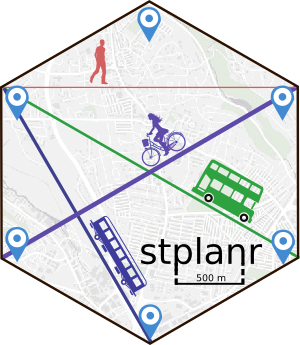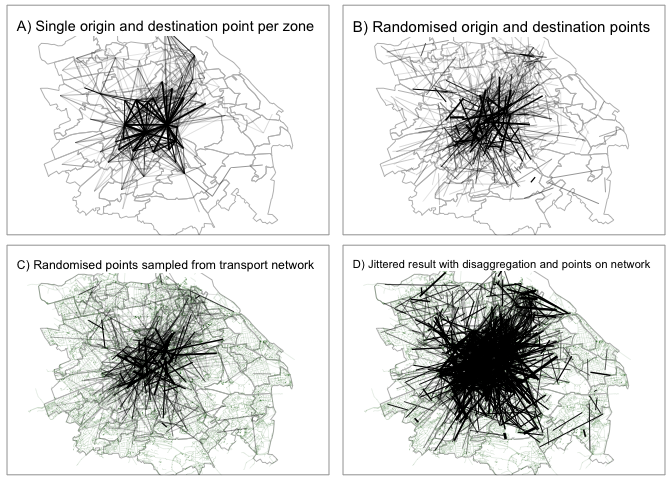Assessing methods for generating route networks from origin-destionation data
Jittering, routing, and visualisation
GISRUK 2022, Liverpool
Robin Lovelace, University of Leeds
+Rosa Félix, Dustin Carlino, Roger Beecham
2022-4-06
Background

Tools of the trade



- Turing Fellowship
- LIDA internship on open transport infrastructure data
- Links with DfT, MHCLG, TfNH, international partners
Tools of the trade



Evidence-based policies in government: Data Science Fellowship at N. 10
Future areas of development: Reproducible Bayesian modelling of proportions (Dirichlet regression), Machine Learning, Decarbonisation Agenda
- Turing Fellowship
- LIDA internship on open transport infrastructure data
- Links with DfT, MHCLG, TfNH, international partners
I am an all-round data scientist with experience with Python, Julia, and command line tools such as Docker and shell scripting for scalable data science applications.
I have particular expertise in R and geocomputation with R in particular.
What is Jittering?

Source: Lovelace, R., Félix, R., & Carlino, D. (2022, January 13). Jittering: A computationally efficient method for generating realistic route networks from origin-destination data. Transport Findings, in Press https://doi.org/10.31219/osf.io/qux6g
Current default: centroid-based desire lines (+routes+rnets)

Jittering in action: minimal reproducible example

Jittering a larger dataset
Adding value and detail to existing OD data. Source: Lovelace, Félix and Carlino (2022 preprint)

Resulting route network

Validating the approach: this paper!
Problem: we need a validation dataset
Validating the approach: this paper!
Problem: we need a validation dataset

Model experiments: jittering parameters

Results!

Code!
See reproducible repo + manuscript here: https://github.com/Robinlovelace/odnet
System command line implementation (compile Rust code):
cargo install --git https://github.com/dabreegster/odjitterodjitter jitter --od-csv-path od_iz_ed.csv \ --zones-path iz_zones11_ed.geojson \ --subpoints-path road_network_ed.geojson \ --max-per-od 10 --output-path output_max50.geojsonR implementation
remotes::install_github("dabreegster/odjitter", subdir = "r")od = read_csv("od_iz_ed.csv")od_jittered = odjitter::jitter( od = od, zones = sf::read_sf("iz_zones11_ed.geojson"), subpoints = sf::read_sf("road_network_ed.geojson") )Next steps
Exploring the parameter space: different origin and destination points + weights, routing 'engines', disaggregation.
Selection of input data: open options
- Traffic count data
- Urban Observatory type data (Newcastle, Birmingham, Manchester)
- Faceboook and Google open mobility data
- 'OSM2od' - spatial interaction model
- Modelled data
- jittering: spatial disaggregation
- temporal disaggregation
Non-open data data
- National Travel Survey
- Mobile Telephone Data
- Large GPS type data (biobank, Google timeline, Straval)
Reproducible example
u = "https://github.com/ITSLeeds/od/releases/download/v0.3.1/od_intra_top_sf.geojson"desire_lines_oa_wpz_1k = sf::read_sf(u)oas_in_buffer = sf::read_sf("https://github.com/ITSLeeds/od/releases/download/v0.3.1/oas_in_buffer.geojson")wpz_in_buffer = sf::read_sf("https://github.com/ITSLeeds/od/releases/download/v0.3.1/wpz_in_buffer.geojson")library(tmap)tmap_mode("view")## tmap mode set to interactive viewingm = tm_shape(desire_lines_oa_wpz_1k) + tm_lines() + tm_shape(oas_in_buffer) + tm_dots(col = "darkgreen") + tm_shape(wpz_in_buffer) + tm_dots(col = "darkred")See here for map

From OD data to policy tools
Lead Developer of the DfT's PCT (Lovelace et al. 2017) : transformational impact on planning in the UK (source: REF Impact Case Study)
COVID response: RAPID tool (Lovelace et al. 2020)
ActDev tool for informing planning process
Open source software, community building
- New high performance libraries

Thanks, look forward to working with you 🖧 + 📈 + ✨ = 🚀!
Thanks, look forward to working with you 🖧 + 📈 + ✨ = 🚀!
References
Thanks, look forward to working with you 🖧 + 📈 + ✨ = 🚀!
References
Lovelace, R., Goodman, A., Aldred, R., Berkoff, N., Abbas, A., Woodcock, J., 2017. The Propensity to Cycle Tool: An open source online system for sustainable transport planning. Journal of Transport and Land Use 10. https://doi.org/10.5198/jtlu.2016.862
Thanks, look forward to working with you 🖧 + 📈 + ✨ = 🚀!
References
Lovelace, R., Goodman, A., Aldred, R., Berkoff, N., Abbas, A., Woodcock, J., 2017. The Propensity to Cycle Tool: An open source online system for sustainable transport planning. Journal of Transport and Land Use 10. https://doi.org/10.5198/jtlu.2016.862
Morgan, M., Lovelace, R., 2020. Travel flow aggregation: nationally scalable methods for interactive and online visualisation of transport behaviour at the road network level. Environment & Planning B: Planning & Design. https://doi.org/10.1177/2399808320942779
Thanks, look forward to working with you 🖧 + 📈 + ✨ = 🚀!
References
Lovelace, R., Goodman, A., Aldred, R., Berkoff, N., Abbas, A., Woodcock, J., 2017. The Propensity to Cycle Tool: An open source online system for sustainable transport planning. Journal of Transport and Land Use 10. https://doi.org/10.5198/jtlu.2016.862
Morgan, M., Lovelace, R., 2020. Travel flow aggregation: nationally scalable methods for interactive and online visualisation of transport behaviour at the road network level. Environment & Planning B: Planning & Design. https://doi.org/10.1177/2399808320942779
Lovelace, R., Tennekes, M., Carlino, D., 2021. ClockBoard: a zoning system for urban analysis. https://doi.org/10.31219/osf.io/vncgw
Thanks, look forward to working with you 🖧 + 📈 + ✨ = 🚀!
References
Lovelace, R., Goodman, A., Aldred, R., Berkoff, N., Abbas, A., Woodcock, J., 2017. The Propensity to Cycle Tool: An open source online system for sustainable transport planning. Journal of Transport and Land Use 10. https://doi.org/10.5198/jtlu.2016.862
Morgan, M., Lovelace, R., 2020. Travel flow aggregation: nationally scalable methods for interactive and online visualisation of transport behaviour at the road network level. Environment & Planning B: Planning & Design. https://doi.org/10.1177/2399808320942779
Lovelace, R., Tennekes, M., Carlino, D., 2021. ClockBoard: a zoning system for urban analysis. https://doi.org/10.31219/osf.io/vncgw
Lovelace, Robin, Rosa Félix, and Dustin Carlino. “Jittering: A Computationally Efficient Method for Generating Realistic Route Networks from Origin-Destination Data.” OSF Preprints, January 13, 2022. https://doi.org/10.31219/osf.io/qux6g.

 Source: Morgan and Lovelace (
Source: Morgan and Lovelace (


 Source: Lovelace, Tennekes, Carlino (
Source: Lovelace, Tennekes, Carlino (